
How Montreal Made Ammonia Safe for Its Rinks
June 8, 2021 | By Colleen O'Shea
The city has transitioned arenas away from R-22 using a design that ensures the safety of staff, patrons and surrounding neighbourhoods.
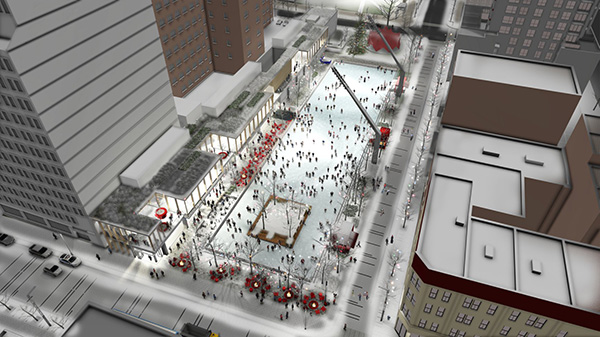
Rendering of Esplanade Tranquille in the heart of downtown Montreal, the City’s latest outdoor ice rink project which is nearing completion. (DesignMontreal)
Montreal is the second-largest city in Canada, and when it comes to ice arenas, the city stands out, now counting over 50 refrigerated indoor and outdoor facilities. Montreal is also the birthplace of the Montreal Protocol on Substances that Deplete the Ozone Layer (1987), the international treaty to phase out man-made ozone depleting substances, an agreement that continues to make an impact on the refrigeration industry, including arenas.
For two decades before the Montreal Protocol was signed, the bulk of arenas were built with refrigeration plants employing R-22, a non-flammable and non-toxic refrigerant. Unfortunately, it was found to be an active contributor to the growing hole in the ozone layer.
Montreal committed to converting its ice arenas away from R-22 by 2020, and that task was charged to Claude Dumas, P.Eng., a mechanical engineer working for the city. “Approaching a project, I always wear two hats: the hat of an engineer and the hat of an owner,” says Dumas.
He was a good choice for the job. After graduating in 1966 from the Polytechnique Montreal, Dumas spent 15 years working as a technical representative for two different manufacturers, Carrier then York, and then he spent eight years as a consulting engineer for the largest engineering firm in Quebec at the time, TECSULT, which later merged with AECOM, where he worked on energy efficiency projects for Montreal’s arenas, among other projects. When the city advertised for a project lead, facilities, Dumas was quick to apply. He’s been there ever since.
No Small Task
In replacing the R-22 in existing arenas Montreal wanted a safe, efficient, refrigeration system with a design that could be replicated. Those requirements may sound evident, but developing a replicable solution was not.
In 2005, when the project began, ammonia was becoming the refrigerant of choice. Although having the lowest possible rating for its ozone depletion (ODP) and global warming potential (GWP), ammonia is a dangerous, caustic chemical which can hurt and kill. An ice plant requiring 5,000 lbs (2258 kg) of ammonia was far from acceptable.
Jean-Paul Lacoursière, another 1966 Polytechnique mechanical grad and now a chemical engineering professor and risk management expert at the University of Sherbrooke, was recruited to assist with the project. Both Dumas and Lacoursière were aware of how dangerous ammonia could be. They were teenagers when an explosion caused by an ammonia tank ripped apart the Molson Brewery at Montreal’s waterfront in 1956, killing its 32-year-old chief night brewer and injuring two others.
Their challenge: how could they lower the risk of an ammonia leak, and how small of an ammonia inventory could it carry? It took three re-designs to get the charge down to 250 lbs (115 kg). In 2006, it was approved, and the team began to implement the design at a rate of four arenas per year.
By 2010, with half a dozen retrofits completed, the team found the standardized design could be improved, bringing the ammonia charge down to 175 lbs, and bringing the condenser inside so all ammonia was isolated in the mechanical room.
Since 2010, Montreal has used a similar design for retrofits and new builds. Here’s how the city made ammonia safe for its rinks:
- The ammonia inventory was limited by replacing shell-and-tube vaporizers with plate-and-frame heat exchangers.

Figure 1. Schematic of four-pass system with evaporators in series. (Claude Dumas, P.Eng., City of Montreal)
- A 4-pass floor design (see Figure 1) was developed in 1991 when Dumas and his team faced a series of corroded steel brine headers. Their floors had used a 2-pass network of pipe (running brine) embedded in the concrete slab to remove heat from the ice with the evaporators connected in parallel and using 25-HP brine pumps. By implementing a 4-pass system with the evaporators piped in a series, they were able to reduce the size of the headers, cut the flow rate in half, reduce the specific gravity of the brine from 1.25 down to 1.18 (at 60F) [which reduced the pump energy consumption], and reduced the brine pump from 25- to 15-HP.
- The surge drum, in place to separate refrigerant droplets from gas, was replaced by a U-Turn Separator, a refrigerant separator developed by AlfaLaval. Designed for use with plate-and-frame heat exchangers in ammonia applications, the 8-in. U Turn Separator ensures minimum pressure drop losses and maximum energy efficiency. It also prevents the ammonia droplets from going into the compressor.
- The plate and frame evaporator was re-sized for a liquid leg of ammonia half the height of the unit. This innovation reduced the refrigerant load taking it from 250 lbs (2005 design) down to 168 lbs. (2010 design).
- They stopped ammonia from leaving the building altogether using an ammonia-to-glycol plate heat exchanger combined with a fluid cooler in place of an evaporative condenser. This eliminated the risk of ammonia going down to the ground, or going out over the building.
- As an additional safeguard, an “air washer” was added to the ventilation system in the mechanical room to wash the air before exhausting it to the outside in case of any ammonia contamination.
- Improvements were also added to the mechanical ventilation to exhaust a potential accumulation of ammonia due to leaks or a rupture of the system by using ANSI/IIAR2-2014 Standard. This ensures the machinery room emergency ventilation discharges vertically upward with a minimum discharge velocity of 2,500 ft/min at the emergency ventilation flow rate to prevent the ammonia from coming down to the ground.
- Ammonia pressure relief valves were directed to a tank containing 8 kg. of water per kg. of ammonia that would be released from the largest relief valve within one hour to avoid impacting neighbours in case of an accidental release.
- The biggest risk of ammonia exposure to arena workers was in draining the oil that accumulates in the oil pot before adding oil to each of the compressors—a monthly task required for each of the compressors. The city worked with the refrigeration engineering firm of Petropoulos, Bomis & Assoc. and developed an on-demand, fully enclosed oil recycling system. This innovation was awarded for Project Excellence by ASHRAE in 2017.
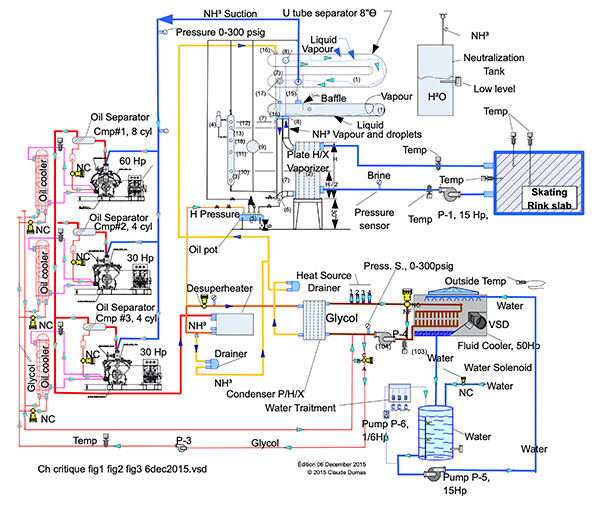
The complete refrigeration system with the lower ammonia charge. (courtesy Claude Dumas, P.Eng., City of Montreal)
Successful Solution
Montreal recently completed its final R-22 conversion and continues to use its 2010 design for new builds. In January, as is his custom, Dumas was on site for the pouring of the city’s latest outdoor project, the Esplanade Tranquille in the heart of downtown.
Envisioned as an urban terrace in the summer, it will become a skating surface in the winter. The near Olympic-sized rink will be supported by a 9-in. slab, accounting for the heavy summer foot-traffic. Petropoulos, Bomis & Assoc. is the refrigeration engineer and LS Refrigeration is the sub-contractor.
For the Esplanade Tranquille, the refrigeration system is comprised of:
- Plate and frame heat exchanger (p/h/x) for the evaporator and the condenser.
- The heat exchanger pipes, buried in the refrigerated floor, are 1-in. ID steel pipe, schedule 40.
- The heat transfer fluid in the p/h/x evaporator and the rink heat exchanger is a brine composed of calcium chloride and water.
- The plant uses three 100-HP reciprocating compressors, belt driven, 1000 rpm, 59.1 Tr, x 3 = 177.3 Tr.
- The refrigeration capacity ratio is: 19619.4 ft²/177 Tr = 110.6 ft²/Tr
- A critical charge of R-717 (ammonia) refrigerant. The refrigerant charge is estimated to be less than 400 lbs; the real charge will be discovered upon system start-up.
- One U-turn separator instead of a surge drum.
- The heat rejection devices are air cooled dry coolers.
- Ethylene glycol (EG) is used as heat transfer fluid between p/h/x condenser and the dry coolers.
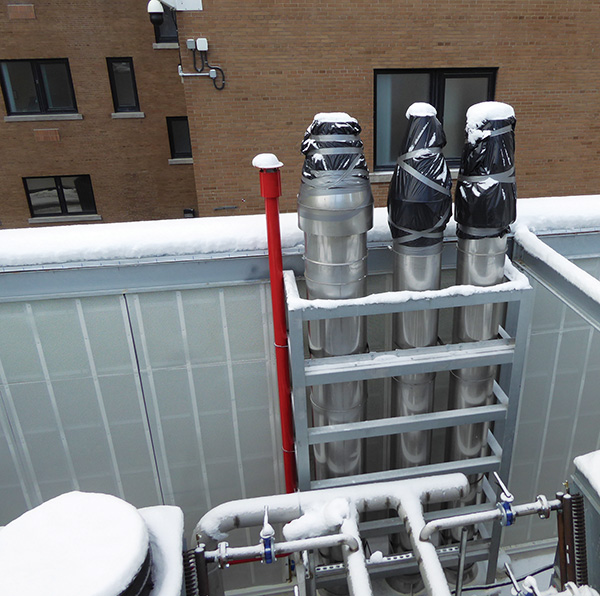
Esplanade Tranquile: The red vent is for the ammonia relief system. The three chimneys correspond to the three ventilation systems in the Class T machinery room. The large one is for heat ventilation, middle is for the min. ventilation as per CSA B-52 and the third is for evacuation of the air washer in case of an ammonia leak. Note the acceleration cone: the air will be propulsed vertically, at high speed. Also evident is how close the neighbours are, so safety is paramount. (photo courtesy Claude Dumas)
The mechanical room is built on two levels, where the main floor is 12 ft. lower than the rink, with a mezzanine, control room and access, located at ground elevation.
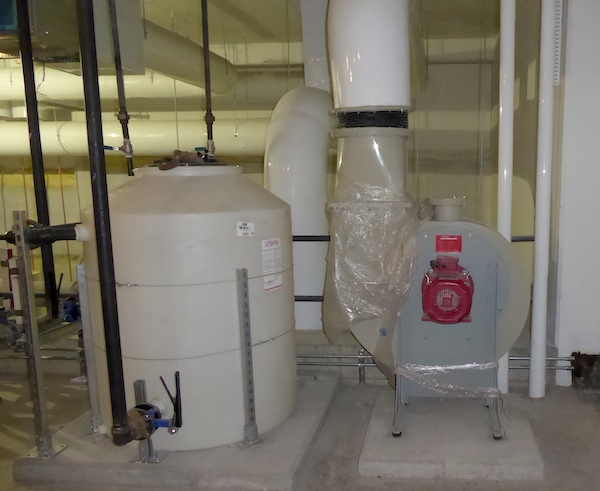
In the mechanical room, the big reservoir (left) is the expansion tank for the brine system. Next to it is the fan, which will work in conjunction with the air washer to clean the air in case of an ammonia leak. Both the fan and air washer are of plastic construction for corrosion resistance. All made in Montreal by Cy-Bo.
(photo courtesy of Claude Dumas)
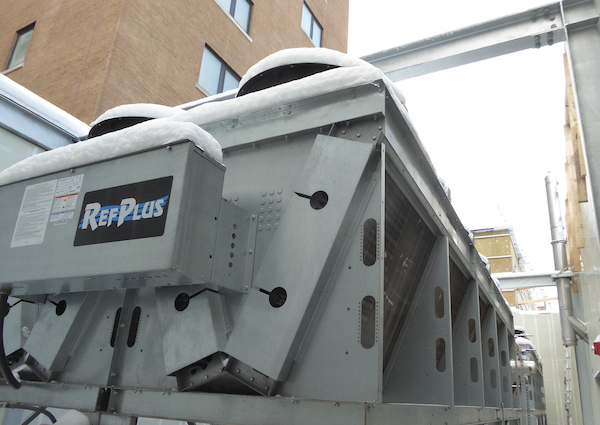
The air-cooled heat rejection device at Esplanade Tranquille. Ethylene glycol carries the heat away from the condenser and brings it to this dry cooler. A dry cooler can be used because the outdoor skating rink will only operate in the winter.
(photo courtesy of Claude Dumas)
Encouraging Change
Montreal’s ammonia refrigeration design has been proven for a decade. An estimated 400 arenas within the province of Quebec are still using R-22 and packaged systems. Montreal’s low-charge design is now becoming available from specialist refrigeration companies making ammonia refrigeration safer than ever before. <>




